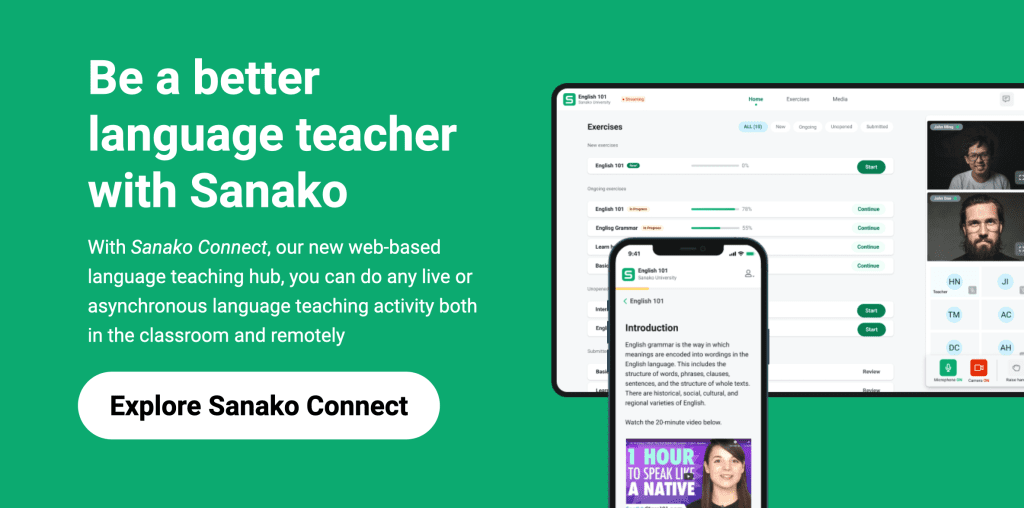One of the great benefits of language learning is that it opens up new horizons, offering students the chance to explore different cultures, broaden their perspectives and forge lifelong connections. However, not all language learning approaches are created equal. One key factor that significantly impacts the effectiveness of language acquisition is the use of authentic language learning content and context.
This is important for the assessment of learning but also for the type of learning tasks and learning materials deployed. Teachers take the lead in these areas and so it’s important they prioritise authentic resources to build relevance and familiarity for learners.
In this blog post, we will explore why authentic content is so crucial for language learning and how it can transform students’ learning experience. We’ll also highlight how world language educators can effectively use it everyday in their classrooms.
What is authentic language learning content?
Essentially, this term refers to materials (e.g audio, text or video) used in a lesson or language learning task that have not been specifically created for language learning purposes. The materials would have originally been created for native speakers and usually come from genuine or real sources such as magazines, podcasts or radio programmes. Each teacher then builds a series of questions and activities around the authentic stimulus material to create a lesson that’s tailored to the needs of their students.
Authenticity is also relevant when choosing the tasks that students do in class or for extended individual learning (Picardo & Gallante, 2018). Educators should ensure that all activities are relevant to what learners might actually do with their L2 language skills outside of the classroom. Rather than set tasks that are simply designed to keep students busy or focused on generic rote-learning.
Why is authenticity so important?
There are lots of advantages to teaching languages using authentic texts and materials.
1. Meaningful engagement
Authentic context provides learners with real-life scenarios and practical situations in which they can apply their language skills. Instead of focusing solely on grammar rules and vocabulary lists, learners are encouraged to engage with the language as it is used naturally. This approach fosters meaningful interactions and deepens the understanding of the language and the full range of colloquial expressions and slang. As a result, learners become more confident in using their L2 in real-world settings.
2. Cultural understanding
Language and culture are inseparable. By learning a language within its authentic cultural framework, learners gain insight into the beliefs, traditions, values, and everyday practices of native speakers. Understanding cultural subtleties is crucial for effective communication, as it helps learners avoid misunderstandings and adapt their language use to diverse social situations.
3. Motivation and interest
Traditional language learning methods that focus solely on pre-prepared materials (e.g. textbooks) and drills can be monotonous and demotivating for learners. Authentic context, on the other hand, ignites a sense of curiosity and enthusiasm among learners. As they explore real-life materials like films, news articles and conversations with native speakers, learners are immediately able to see the practical applications of their language skills. This helps build motivation and encourages learners to persist with their studies.
4. Enhanced retention
Authentic context enhances language retention by creating strong cognitive associations. Rather than memorising isolated words or phrases, learners acquire language within the context of meaningful situations. This association with real-world experiences helps reinforce memory and recall. As a result, learners can more easily retrieve the language they have learned and apply it effectively when encountering similar scenarios.
5. Improved communication skills
Language learning is not just about understanding grammar and vocabulary; it’s also about becoming an effective communicator. Authentic context provides learners with opportunities to practise their core skills in a way that mirrors real-life communication. This practical approach hones their language skills, enabling them to communicate confidently and naturally in various social and professional settings.
How can I use authentic materials in my language teaching?
There are a wide variety of ways in which English and Foreign language educators can introduce authentic materials into their teaching to reflect the target language’s everyday usage. They can be used to encourage students to analyse / discuss the content as well as fostering critical thinking skills and language comprehension. The following strategies may be of interest for modern world language educators regardless if they are teaching Spanish, French, Chinese, Japanese, Arabic, English or any language for that matter:
- Role-play and simulations: Create scenarios that simulate real-life situations, such as ordering food at a restaurant, making travel arrangements or conducting a job interview. Role-play activities allow students to practise their language skills in context, which boosts their confidence and fluency.
- Language immersion: Build a fully immersive classroom environment by incorporating the target language in all of your everyday routines, greetings and interactions. Use the language naturally during class discussions and encourage students to communicate with each other in the target language.
- Cultural initiatives: Introduce projects that encourage students to research and present key aspects of their target language’s culture. This could be focused on items of topical interest such as environmental or political issues.
- Community engagement: Encourage students to interact with local native speakers in their community or with other language learners at language clubs, for example. Maximising opportunities for real-world conversations outside the classroom is the aim here!
- Learning through media: TV shows, tweets and TikToks all expose students to authentic conversations and language usage. Take students’ learning to the next level by adding tailored comprehension activities related to these materials.
- Authentic writing tasks: Assign writing tasks that require students to write emails, letters, or blog posts in the target language. As above, students could even draft tweets or Instagram posts to build their skills. All of these settings help them to practise language use in relevant contexts.
- Encourage exchange programmes: Collaborate with teachers and schools from other countries to set up exchange programmes. These can be virtual or face-to-face, but provide invaluable exposure for students to engage with native speakers with different accents and dialects.
The importance of authentic content and context in language learning cannot be overstated. It enriches the learning experience and helps learners develop a deeper appreciation for the language and the people who speak it. The focus on real-life language production also highlights the progress learners have made and demonstrates the application of their skills when they completed their course.
How do Sanako products support the use of authentic materials?
Sanako’s market-leading tools offer unique features that support language educators to use authentic materials in their teaching. That’s why top educational institutions choose Sanako as their preferred supplier for both online and in-person lesson delivery.
Using the Sanako Connect online language teaching platform, educators can:
- Create engaging and creative lessons using a wide variety of authentic stimulus materials. Sanako Connect allows teachers to easily upload interactive content, PDFs, presentations, videos, audio clips and full web pages to share with students in online lessons. Teachers can then add in and mix and match a range of interactive tasks that utilise this content such as speaking and listening tasks, pronunciation exercises with automated grading, gap fill, multiple choice questions, digital flashcards and more.
- Provide easy access to these lesson resources synchronously and asynchronously. Students can participate flexibly from anywhere with an internet connection and conveniently access all language lesson resources within the Connect application.
- Customise teaching to meet individual student needs. Sanako Connect helps language educators track student engagement in every lesson, notifying them about students’ speaking practice and interaction with translation exercises. This helps teachers monitor progress and target areas for improvement with specific lessons and resources.
- Offer ample opportunities for practising core language skills. Sanako Connect is designed to increase speaking practice and active conversations during classes, whether conducted in the classroom, in hybrid mode or remotely.
Sanako is the global-leader in teacher-led language instruction technology. Our software supports language teachers to deliver inspiring and effective lessons. If you’d like to find out more about how Sanako’s dedicated language teaching software could transform your approach to language teaching, click here or the banner below to learn more!

